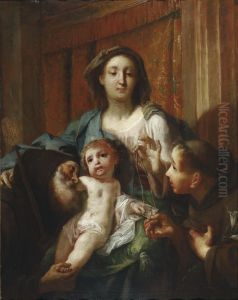Giambattista Crosato Paintings
Giambattista Crosato was an Italian painter born in 1686 in Venice, a city renowned for its artistic vibrancy and rich cultural scene during the Baroque period. Crosato showed an early talent for painting and was likely exposed to the Venetian tradition of colorito, characterized by a rich application of color, which became a hallmark of his style.
Not much is documented about Crosato’s early life or his artistic training, but it is believed he was influenced by the works of the leading Venetian painters of the time, such as Giovanni Battista Tiepolo. Crosato’s work also exhibits the influence of the dynamic and theatrical compositions typical of the Baroque movement that dominated European art in the 17th and early 18th centuries.
Crosato's career is marked by his contributions to the decoration of various buildings with frescoes and paintings, particularly in Northern Italy. He was known for his grandiose ceiling frescoes, which were imbued with lightness and elegance. His work often featured mythological and allegorical scenes, executed with a masterful understanding of perspective and a palette that reflected the transition from the high Baroque to the Rococo style.
One of Crosato's significant works is the ceiling fresco in the Palazzo Clerici in Milan, which showcases his ability to create an illusion of three-dimensional space on a two-dimensional surface, a technique known as quadratura. This work exemplifies his expertise in seamlessly integrating architectural elements with painted scenes to create a harmonious and immersive experience.
Despite his talent, Crosato did not achieve the same level of fame as some of his contemporaries. His work was often overshadowed by that of more prominent artists such as Tiepolo. Nonetheless, Crosato's contributions to the Italian Baroque period remain noteworthy for their artistic quality and the role they played in the evolution of fresco painting during the era.
Giambattista Crosato passed away in 1758. While he may not be as widely known as other Baroque masters, his work continues to be appreciated for its beauty and technical skill. His art is a testament to the rich tapestry of Italian Baroque painting and offers valuable insight into the period's stylistic developments.
